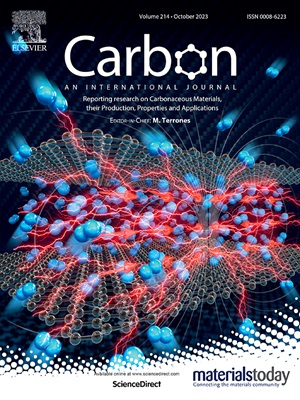Combustion synthesis of carbon hollow nanocubes: DFT modelling and electrochemical performance analysis
IF 10.5
2区 材料科学
Q1 CHEMISTRY, PHYSICAL
引用次数: 0
Abstract
A straightforward, energy-efficient, and scalable combustion synthesis (CS) method for synthesizing graphitized hollow carbon nanocube (G-HCNC) through the magnesiothermic reduction of CaCO3 is developed. By controlling the synthesis temperature, we effectively modulated the size of self-templated MgO nanocubes, thereby influencing the size and surface area of the hollow carbon nanocubes formed on the MgO surface. In our ongoing experiments, the edge size of G-HCNC ranged from 100 to 500 nm, with a 15–50 nm thickness. Remarkably, a specific surface area as high as 977.5 m2/g near the combustion boundary at k = 8 is achieved. When tested as support for Mo2C electrocatalyst, G-HCNC demonstrated low overpotential (120 mV) in the hydrogen evaluation reaction (HER). Moreover, when loaded with 10 % Ag, G-HCNC exhibits an excellent specific capacity (428.9 F/g) in a KOH electrolyte. This development holds promise for generating various complex structures enveloped by graphitized carbon layers for energy storage applications.

碳空心纳米立方体燃烧合成:DFT建模和电化学性能分析
我们开发了一种通过镁热还原 CaCO3 合成石墨化空心碳纳米管(G-HCNC)的直接、节能和可扩展的燃烧合成(CS)方法。通过控制合成温度,我们有效地调节了自模板氧化镁纳米立方体的尺寸,从而影响了在氧化镁表面形成的空心碳纳米立方体的尺寸和表面积。在我们正在进行的实验中,G-HCNC 的边缘尺寸从 100 纳米到 500 纳米不等,厚度为 15-50 纳米。值得注意的是,在 k = 8 时,燃烧边界附近的比表面积高达 977.5 m2/g。在作为 Mo2C 电催化剂的支持物进行测试时,G-HCNC 在氢评估反应(HER)中表现出较低的过电位(120 mV)。此外,当负载 10% 的 Ag 时,G-HCNC 在 KOH 电解质中表现出卓越的比容量(428.9 F/g)。这项研究成果有望在储能应用中产生由石墨化碳层包裹的各种复杂结构。
本文章由计算机程序翻译,如有差异,请以英文原文为准。
求助全文
约1分钟内获得全文
求助全文
来源期刊

Carbon
工程技术-材料科学:综合
CiteScore
20.80
自引率
7.30%
发文量
0
审稿时长
23 days
期刊介绍:
The journal Carbon is an international multidisciplinary forum for communicating scientific advances in the field of carbon materials. It reports new findings related to the formation, structure, properties, behaviors, and technological applications of carbons. Carbons are a broad class of ordered or disordered solid phases composed primarily of elemental carbon, including but not limited to carbon black, carbon fibers and filaments, carbon nanotubes, diamond and diamond-like carbon, fullerenes, glassy carbon, graphite, graphene, graphene-oxide, porous carbons, pyrolytic carbon, and other sp2 and non-sp2 hybridized carbon systems. Carbon is the companion title to the open access journal Carbon Trends. Relevant application areas for carbon materials include biology and medicine, catalysis, electronic, optoelectronic, spintronic, high-frequency, and photonic devices, energy storage and conversion systems, environmental applications and water treatment, smart materials and systems, and structural and thermal applications.
 求助内容:
求助内容: 应助结果提醒方式:
应助结果提醒方式:


